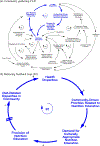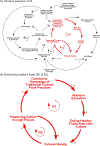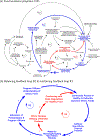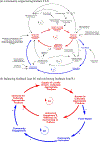Identifying opportunities for collective action around community nutrition programming through participatory systems science
- PMID: 37481755
- PMCID: PMC10979368
- DOI: 10.1007/s10552-023-01751-6
Identifying opportunities for collective action around community nutrition programming through participatory systems science
Erratum in
-
Correction: Identifying opportunities for collective action around community nutrition programming through participatory systems science.Cancer Causes Control. 2024 May;35(5):873-874. doi: 10.1007/s10552-024-01850-y. Cancer Causes Control. 2024. PMID: 38300397 No abstract available.
Abstract
Purpose: To apply principles of group model building (GMB), a participatory systems science approach, to identify barriers and opportunities for collective impact around nutrition programming to reduce cancer risk for immigrant communities in an urban environment.
Methods: We convened four in-person workshops applying GMB with nine community partners to generate causal loop diagrams (CLDs)-a visual representation of hypothesized causal relationships between variables and feedback structures within a system. GMB workshops prompted participants to collaboratively identify programmatic goals and challenges related to (1) community gardening, (2) nutrition education, (3) food assistance programs, and (4) community-supported agriculture. Participants then attended a plenary session to integrate findings from all workshops and identify cross-cutting ideas for collective action.
Results: Several multilevel barriers to nutrition programming emerged: (1) food policies center the diets and practices of White Americans and inhibit culturally tailored food guidelines and funding for culturally appropriate nutrition education; (2) the lack of culturally tailored nutrition education in communities is a missed opportunity for fostering pride in immigrant food culture and sustainment of traditional food practices; and (3) the limited availability of traditional ethnic produce in food assistance programs serving historically marginalized immigrant communities increases food waste and worsens food insecurity.
Conclusion: Emergent themes coalesced around the need to embed cultural tailoring into all levels of the food system, while also considering other characteristics of communities being reached (e.g., language needs). These efforts require coordinated actions related to food policy and advocacy, to better institutionalize these practices within the nutrition space.
Keywords: Cancer disparities; Community engagement; Cultural adaptation; Food system; Immigrant communities; Systems science.
© 2023. The Author(s), under exclusive licence to Springer Nature Switzerland AG.
Figures




References
MeSH terms
Grants and funding
LinkOut - more resources
Full Text Sources

